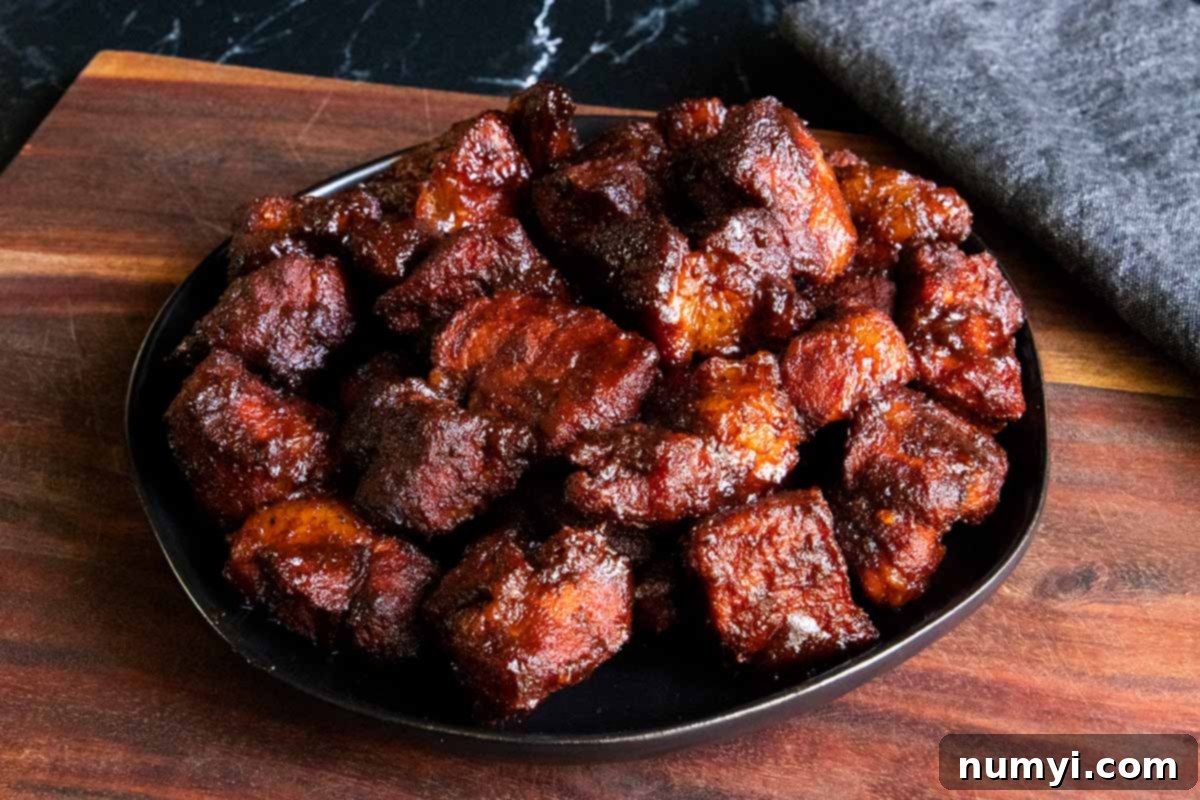Best Smoked Pork Butt Burnt Ends Recipe: Sticky, Sweet & Tender BBQ Perfection
Prepare yourself for a true barbecue masterpiece: perfectly tasty, irresistibly smoky, and incredibly sticky-sweet pork butt burnt ends! These savory morsels are generously coated in a dynamic spicy-sweet glaze that transforms each bite into pure meat candy. It’s a culinary experience that will have you reaching for more, guaranteed to be a new favorite for any smoked meat enthusiast.
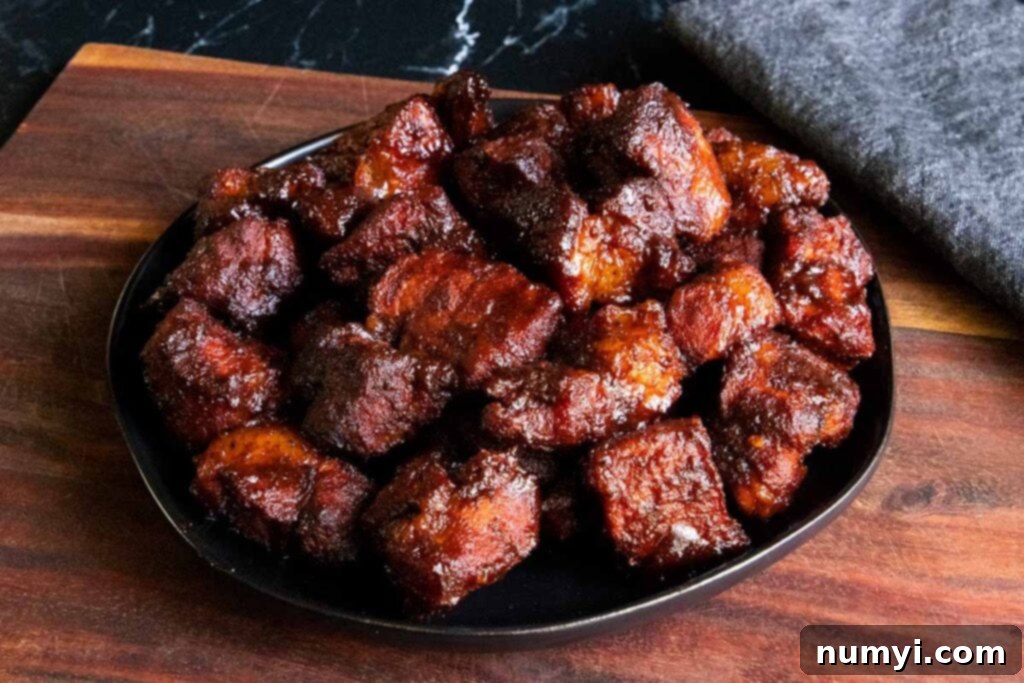
It’s safe to say that burnt ends hold a special place in the hearts of almost everyone who loves barbecue. The rich, concentrated flavor and tender texture are simply unmatched. However, dedicated pitmasters know the commitment required for a full brisket – often a 12-16 hour affair. And while pork belly burnt ends are undeniably delicious, their intense richness can be overwhelming, making it hard to stop at just a few of those decadent bites.
That’s where the idea for this recipe was born – finding the sweet spot, the best of both worlds. The solution? Using a pork butt, also known as a Boston butt. This cut offers a fantastic balance: it boasts excellent fat content that renders down beautifully during the smoking and braising process, combined with ample meaty sections that provide a satisfying, juicy bite. It’s a game-changer for those seeking classic burnt end flavor without the lengthy cook time or extreme richness of other options.
After numerous trials and meticulous adjustments, I’ve perfected a method that delivers everything you crave in exceptional burnt ends. This recipe expertly balances deep smoke flavor, a subtle kick of spice, and that coveted sticky-sweet glaze that makes them truly irresistible. The results are nothing short of fabulous!
These smoked pork butt burnt ends have quickly climbed the ranks to become one of my favorite things to prepare on the smoker. The reduced cook time, combined with an explosion of flavor, makes them an undeniable win. If you haven’t tried this approach yet, you absolutely must. You’ll be amazed at how easily you can achieve such incredible results.
While this versatile method can likely be adapted for various types of grills, my focus in this guide will be specifically on achieving optimal results using a dedicated smoker. Consistent low and slow heat is key to building that incredible bark and infusing deep smoky flavor. Moreover, this recipe is incredibly flexible: whether you’re feeding a small gathering or a large crowd, you can easily cut it in half or double the ingredients as needed. I’ve even had success cubing half of a pork butt for burnt ends and smoking the other half whole for pulled pork, demonstrating its adaptability.
Essential Ingredients for Perfect Pork Butt Burnt Ends
One of the beauties of this recipe is that it doesn’t require a long list of exotic ingredients. The magic largely happens with the rub itself, which is a blend I’ve refined over years of smoking various cuts of meat. It strikes a perfect balance: a slightly sweet and smoky profile with a delightful hint of heat that lingers on the palate. Trust me, once you try this rub, you’ll want to put it on just about everything!
The Star: Boneless Pork Butt
For this recipe, we recommend a boneless pork butt (also known as a Boston butt) weighing approximately 8 lbs. A boneless cut simplifies the preparation, allowing for easier cubing and more consistent pieces. Look for a butt with good marbling, as this fat will render down, keeping the burnt ends incredibly moist and flavorful.
The Signature Rub
All the precise measurements for the rub ingredients can be found in the comprehensive recipe card below. This list provides a quick overview of the spices you’ll be blending to create our signature flavor profile. As I mentioned, this rub truly elevates the pork. It’s carefully crafted to avoid being either oversweet or overwhelmingly spicy, offering a harmonious blend that perfectly complements smoked pork, not just for burnt ends, but for any pork you smoke.
- Paprika
- Smoked paprika
- Garlic powder
- Chili powder
- Kosher salt
- Black pepper
- Onion powder
- Brown sugar
- Dried oregano
- Dried thyme
- Cumin
- Dry mustard
- Cayenne
The Irresistible Glaze
Ah, the moment of truth! This is where the sticky, sweet, and slightly spicy goodness comes to life, turning tender pork into glistening, flavorful “meat candy.” The glaze is designed to add that final, unforgettable layer of flavor and texture without being overly complicated. You’ll find these ingredients readily available at most grocery stores.
- Hot honey (widely available and adds a wonderful sweet heat)
- Brown Sugar
- Your favorite barbecue sauce (choose a brand and style you love)
- Butter
- Some of the remaining rub (ties the flavors together beautifully)
Don’t Sweat The Recipe is supported by its readers. We may earn a commission if you purchase through a link on our site. Learn more.
Crafting the Perfect Pork Butt Burnt Ends: A Step-by-Step Guide
Preparing The Signature Rub
This initial step is wonderfully straightforward, but essential for building flavor. In a medium-sized mixing bowl, combine all the dry rub ingredients listed in the recipe card. Use a whisk or a spoon to thoroughly mix them until they are completely uniform. There should be no clumps, and the spices should be evenly distributed to ensure every piece of pork gets the full flavor treatment. Once mixed, set your homemade rub aside, keeping it ready for when the pork is prepped and waiting to be coated.
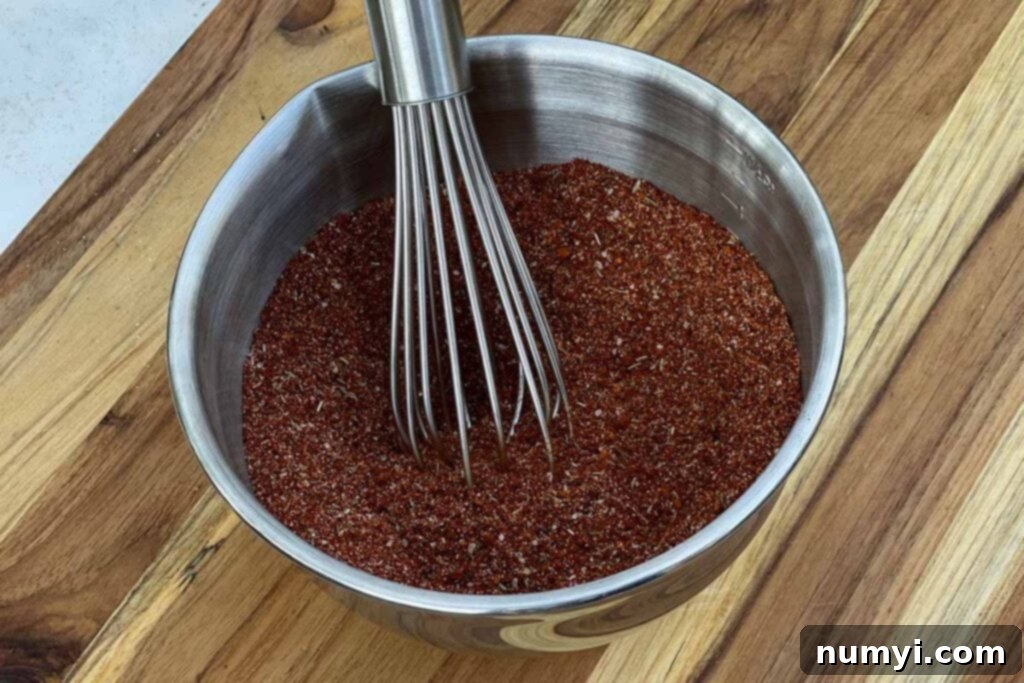
Set the spice mixture aside until the meat is ready for the rub.
Preparing The Pork Butt
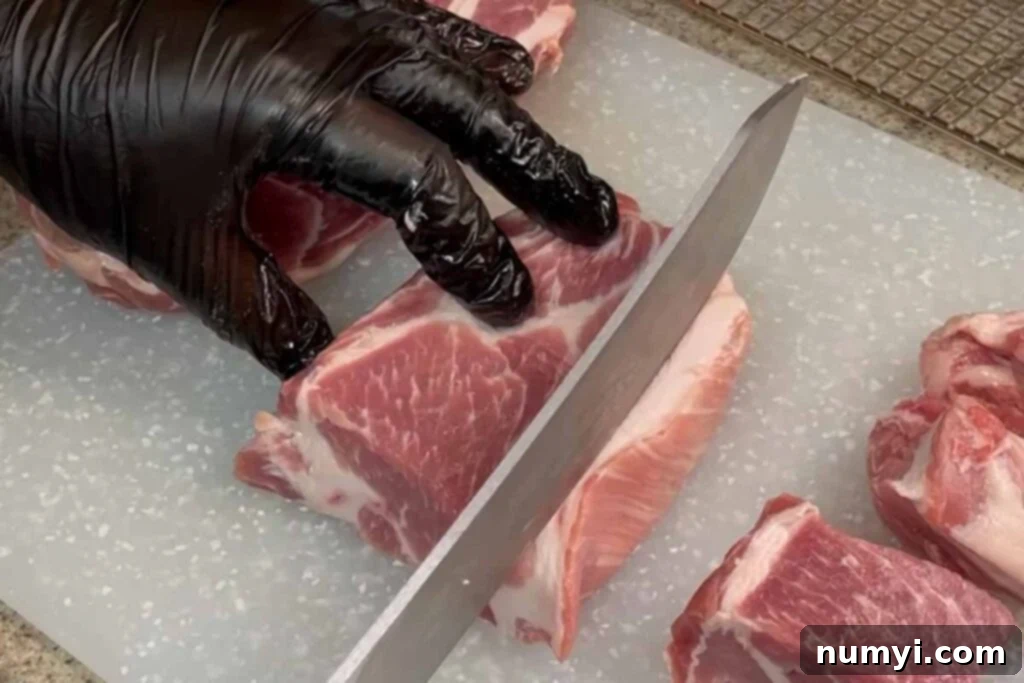
Begin by carefully trimming away most of the large, hard fat deposits from the exterior of the pork butt using a sharp knife. While pork butt has a fantastic internal fat content for juiciness and flavor, excess exterior fat can hinder the formation of a good bark and prevent the rub and smoke from penetrating the meat effectively. Since we’re cutting the pork into smaller cubes, the surface area for smoke absorption is already increased, so a good trim ensures maximum flavor and texture. This initial trim is more aggressive than if you were smoking a whole pork butt, as our goal is flavor on every bite.

Next, cut the trimmed pork butt into uniform 1½ inch cubes. Consistency in size is important for even cooking. You’ll likely encounter some smaller, irregular bits and pieces; it’s best to trim these further or discard them, as they tend to overcook and burn during the smoking process, becoming tough rather than tender. Once your pork is cubed, transfer the pieces into a large receptacle—a mixing bowl or a disposable aluminum pan works perfectly. This will make the next step of applying the rub much easier.
Now, it’s time to apply the rub. I highly recommend using a binder such as yellow mustard before applying the rub. While not strictly required, a thin layer of mustard helps the rub adhere to the meat more effectively and creates a fantastic base for flavor, without imparting a strong mustard taste to the final product. Generously coat all sides of the pork cubes with the dry rub. Sprinkle, mix, and toss the cubes vigorously, ensuring every single piece is thoroughly covered in that delicious spice blend. For an 8 lb pork butt, you’ll typically use about 1 cup of the prepared rub during this initial coating phase, ensuring robust flavor.
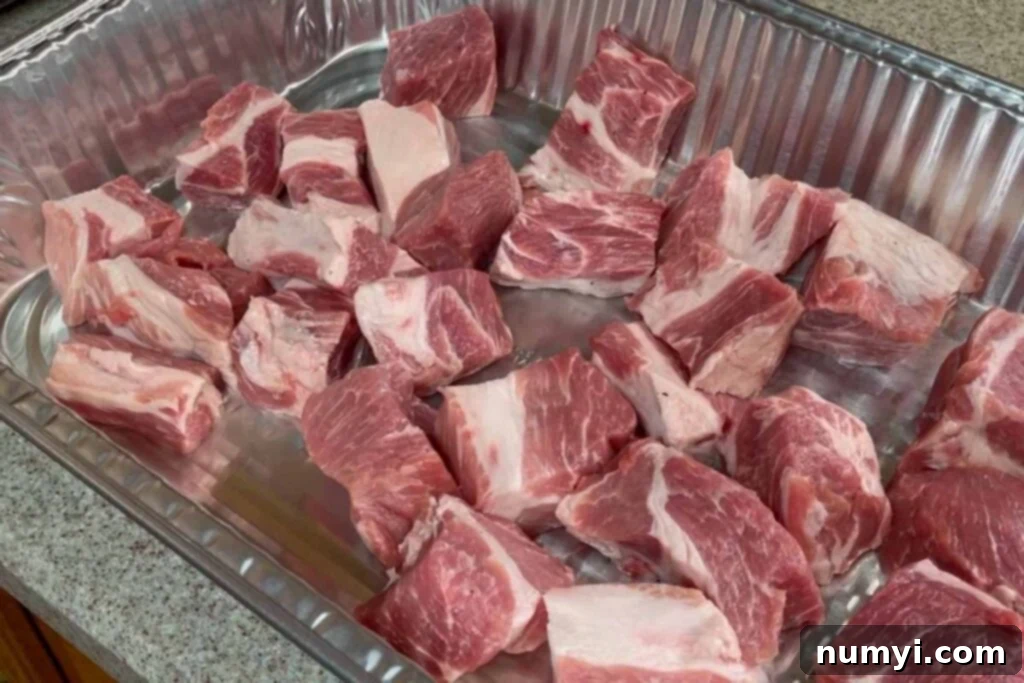
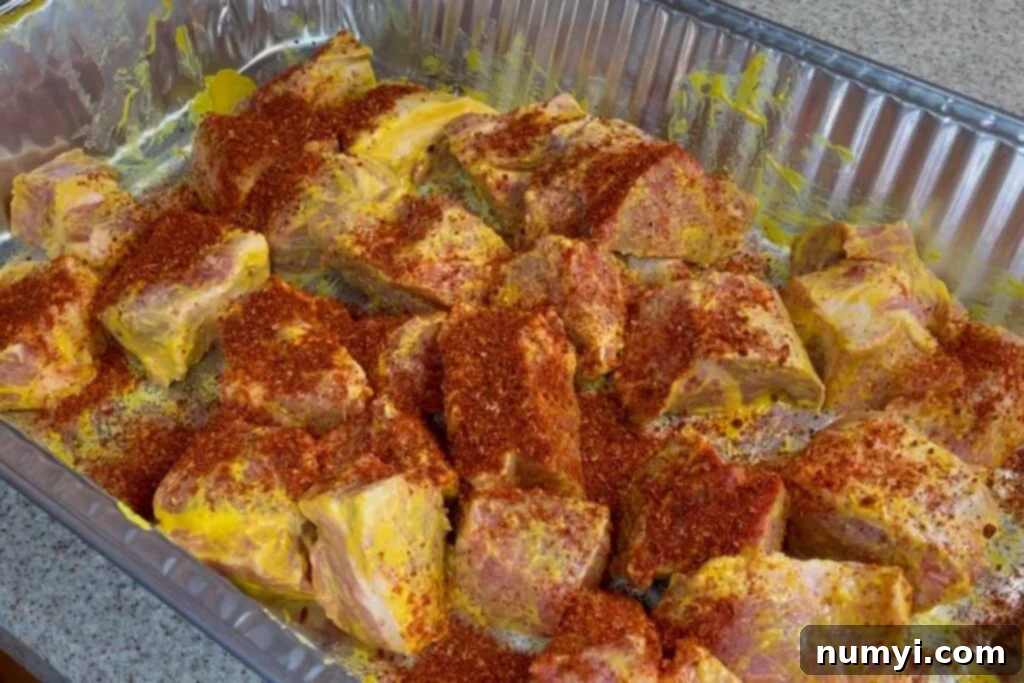
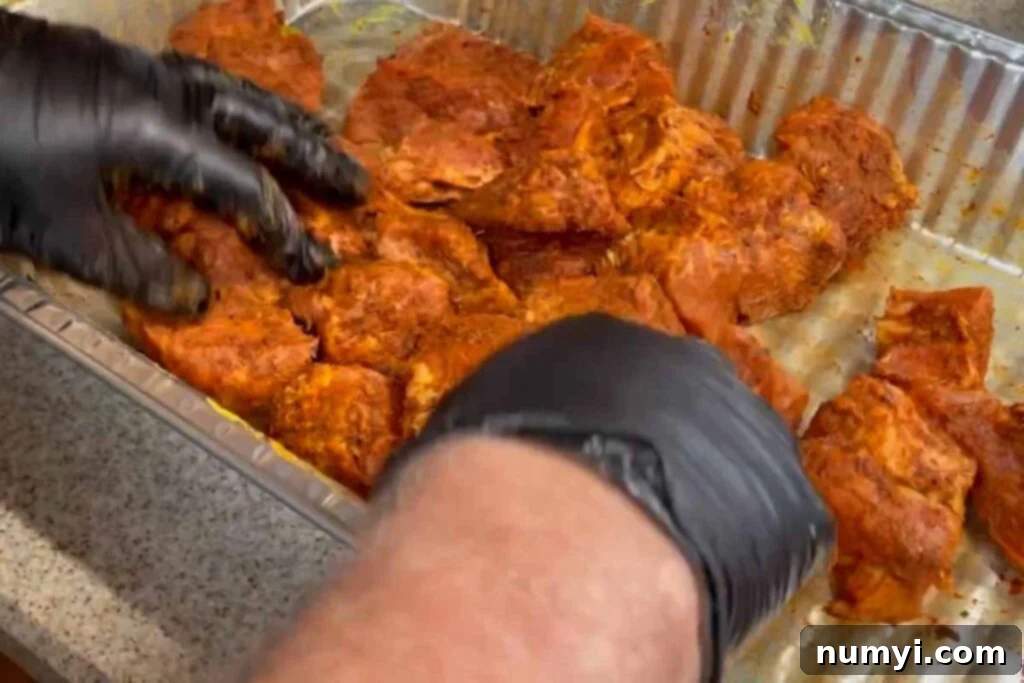
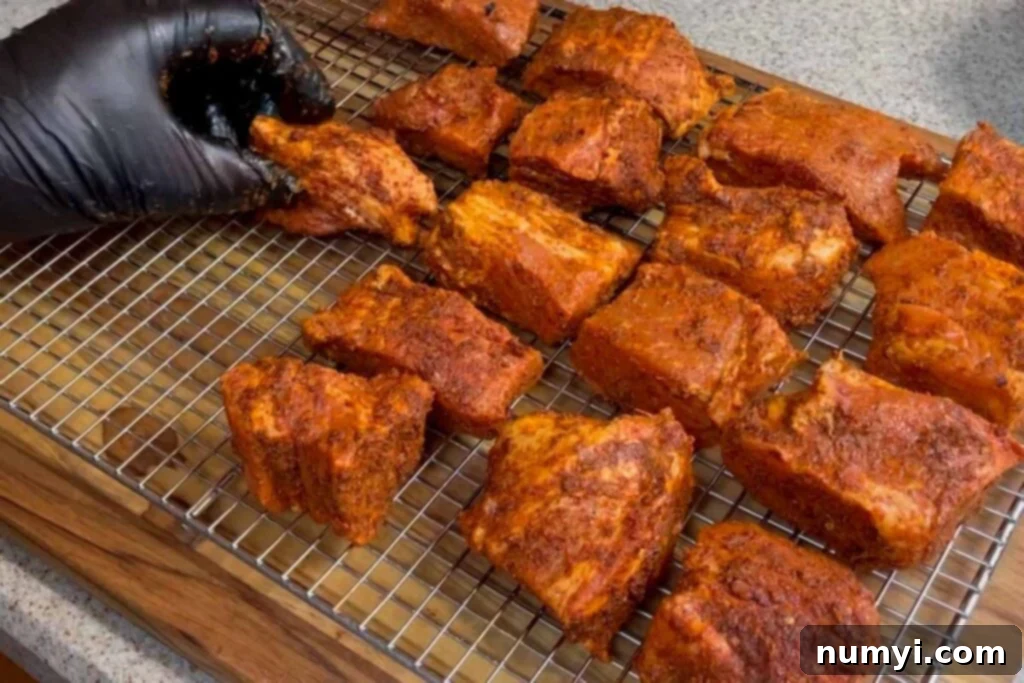
For ease of handling and clean-up, I highly recommend placing the seasoned pork cubes onto baking cooling racks. These racks allow for excellent airflow around each piece, promoting even smoke penetration and bark development. The racks can then be easily transferred to your smoker. Alternatively, you can place the cubes directly onto your smoker grates, but be prepared for a more involved clean-up afterward, as the sticky rub can adhere to the grates.
The Smoking Phase: Building Flavor and Bark
Preheat your smoker to a consistent temperature of 225-250 degrees F. The choice of wood is crucial for developing the characteristic smoke flavor. I personally love a combination of hickory and cherry wood. Hickory provides an assertive, classic smoky flavor that pairs wonderfully with pork, while cherry wood contributes a beautiful, rich mahogany color to the meat and a slightly fruity note. Other excellent options include pecan or oak, each offering a distinct profile. Feel free to use your personal preference, but ensure it’s a wood that complements pork well.
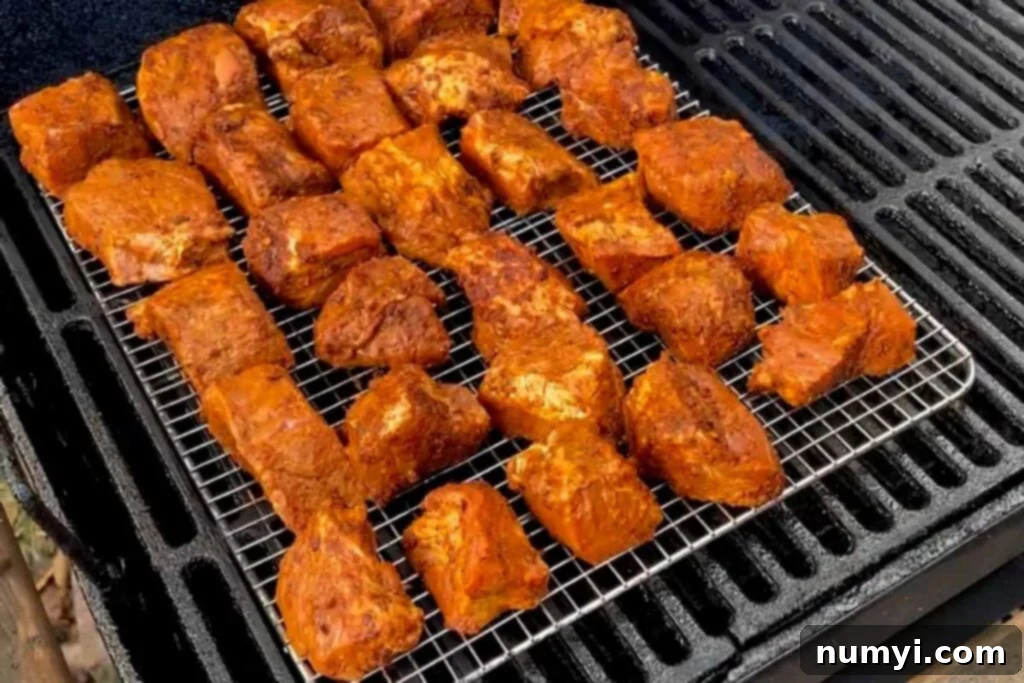
Smoke the pork cubes for approximately 1 hour at your target temperature of 225-250 degrees F. This initial smoking period is primarily dedicated to infusing the meat with that desirable smoky flavor and allowing a flavorful bark to begin forming on the exterior. It’s not about fully cooking the pork at this stage, but rather laying the groundwork for flavor. The internal temperature of the meat should reach around 165 to 170 degrees F during this phase, indicating it has absorbed sufficient smoke and is ready for the next step.
A quick note on monitoring internal temperature: Accurate temperature readings are paramount for perfect barbecue. There are many excellent thermometers available, but I exclusively use and highly recommend two in my kitchen and backyard. The first is an instant-read thermometer, which is indispensable for quickly checking the temperature of any meat. For longer cooks, the Fireboard is an absolute game-changer. I encourage you to research it; it’s an amazing smart thermometer system perfect for any serious backyard barbecue enthusiast!

Once the pork has achieved a good, rich color and a noticeable bark has started to form, carefully remove it from the smoker. At this point, increase your smoker’s temperature to approximately 275 degrees F in preparation for the next crucial stage: braising.
Braising for Unparalleled Tenderness
Yes, braise! This step is the secret to achieving truly fall-apart tender pork butt burnt ends. Through extensive testing and various methods, I’ve found that simply smoking this cut of meat until it’s tender often results in a tougher texture than desired for burnt ends. Braising, however, provides the moist, low-heat environment needed to break down the tough connective tissues in the pork butt efficiently and effectively, delivering incredible tenderness in a timely manner. An added bonus? The braising liquid infuses even more flavor directly into the meat, creating a deeper, richer taste profile.
Carefully transfer your smoked pork cubes into a disposable aluminum tin. These pans are your best friend for this recipe, making cleanup a breeze and containing the braising liquid perfectly. If you don’t have any, now’s the time to stock up!
To create our flavorful braising liquid, add approximately 12 ounces of pineapple juice to the pan. Then, add enough apple juice to cover about half the height of your pork cubes. The exact amount will vary based on the size of your pan, but for an average pan, this is typically around 2 cups. The combination of pineapple and apple juice adds a subtle sweetness and acidity that helps tenderize the pork and enhances its natural flavors.
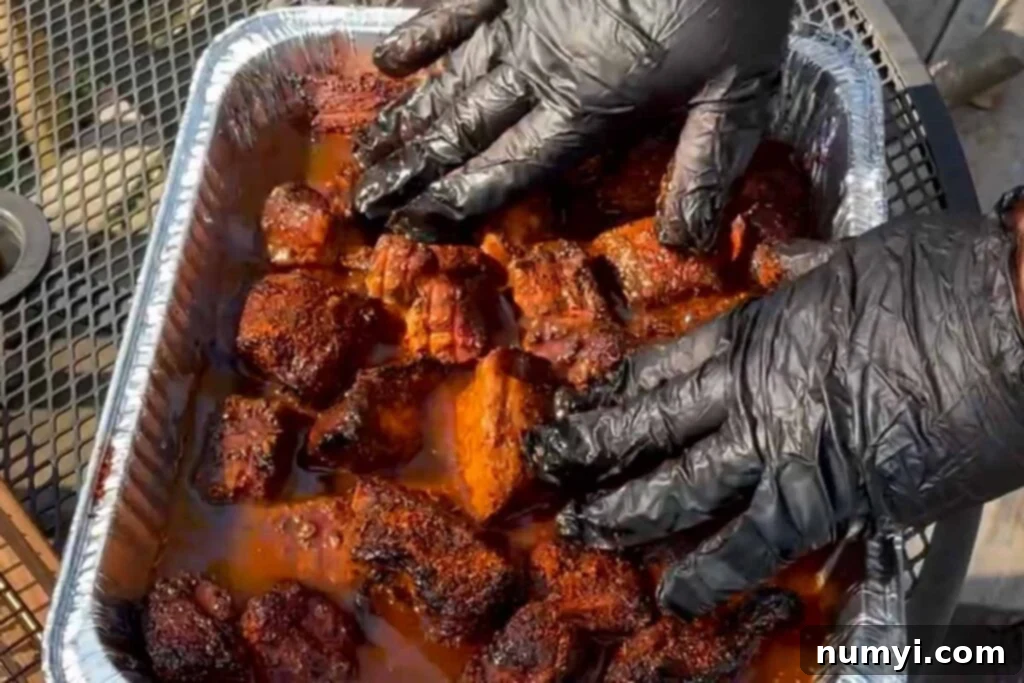
For an extra layer of flavor, sprinkle in a couple of tablespoons of your reserved dry rub into the braising liquid and stir gently to combine. Cover the aluminum pan tightly with foil to create a steamy environment, then place it back onto your smoker, which should now be at 275 degrees F. Braise the pork for about an hour and a half at this temperature.
After the braising period, your pork bites should be significantly more tender. This is where personal preference comes into play. You’ll need to check the meat’s tenderness by carefully probing a piece with a fork or an instant-read thermometer. The internal temperature should be at least 205 degrees F for optimal tenderness. Some prefer burnt ends with a slight ‘pull’ on the bite, while others desire them to be so tender they almost fall apart. After the initial hour of braising, continue checking every 15 to 20 minutes until your desired texture is achieved. Be mindful not to over-braise, as excessively tender meat might make it difficult to handle and glaze without falling apart. It’s all about finding that perfect sweet spot!
Once the meat has reached your personal level of doneness and tenderness, remove the pan from the smoker. Carefully drain all of the braising liquid from the pan. This step is important to prevent the final glaze from becoming too watery.
The Glaze: Creating Meat Candy
This is often the most exciting part of the process – the meat is perfectly tender, and now it’s time to add that crave-worthy, sticky sweetness that defines burnt ends. This final glaze transforms the savory pork into truly irresistible “meat candy.”
To the drained pork cubes in the aluminum pan, add half of the hot honey, your favorite barbecue sauce, brown sugar, melted butter, and two tablespoons of your remaining rub. Using tongs or gloved hands, gently mix all these ingredients with the pork until each piece is thoroughly and evenly coated in the rich, glossy glaze. Make sure every surface is covered to maximize that sticky, sweet-and-savory flavor.
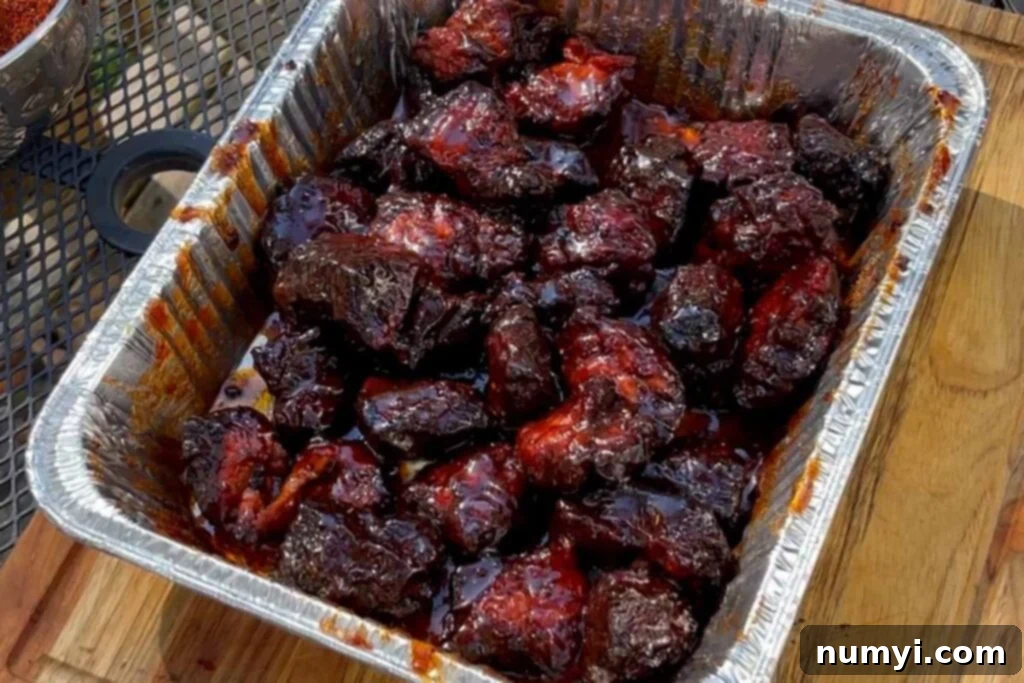
Once glazed, place the pan back onto the smoker, which should still be holding at 275 degrees F. Continue cooking for another 45 minutes, stirring the burnt ends every 15 minutes or so. This final cooking stage allows the glaze to caramelize and “tack up,” forming that signature sticky, slightly chewy exterior that everyone loves. The frequent stirring ensures even coating and prevents any burning.
After 45 minutes, remove the pan from the smoker and allow the pork butt burnt ends to rest for about 10-15 minutes. This brief resting period helps the glaze set and the flavors meld. For an even stickier, more candy-like texture, you can transfer the glazed burnt ends back onto your cooling racks and place them back in the smoker (or oven at 275°F) for an additional 15 minutes. This extra time allows the glaze to further dry and intensify its tackiness.
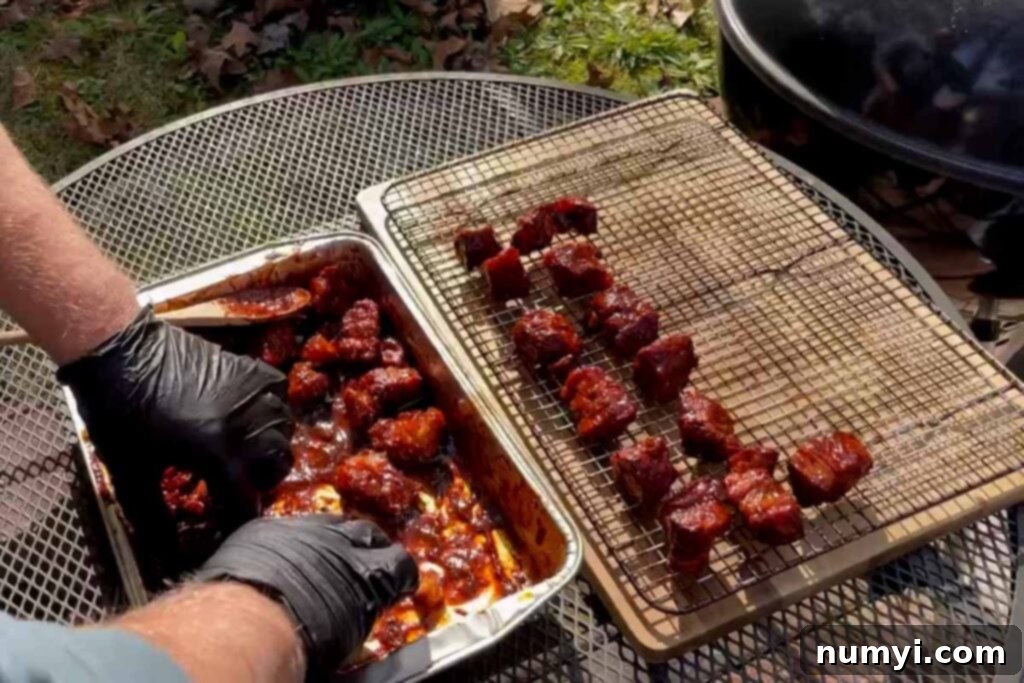
Serving Your Masterpiece

Now, it’s finally time to indulge in this incredible meat candy. The complex flavors of the rub—a perfect blend of sweetness, smokiness, and a touch of heat—combined with the deep, earthy notes from the wood smoke, and then elevated by that irresistible sticky-sweet glaze, create a barbecue nirvana with every bite. The pork itself is wonderfully super tender, practically melting in your mouth, as all these distinct flavors explode in an epicurean firestorm of deliciousness. This recipe truly delivers a sensational barbecue experience.
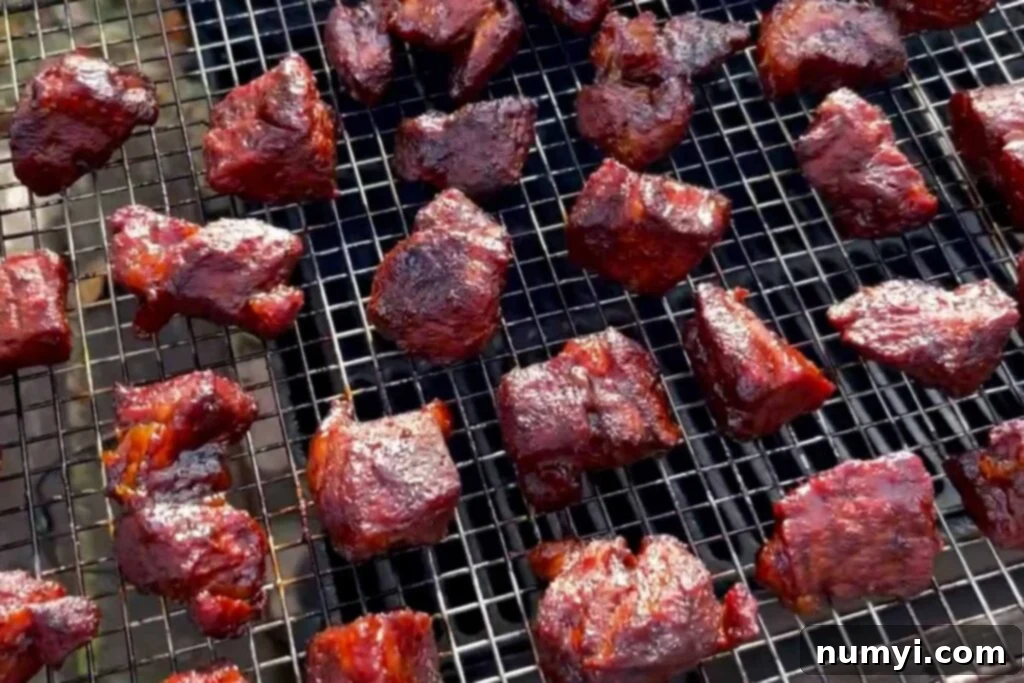
I dedicated considerable time and numerous trials to perfecting this recipe, experimenting with various techniques and ingredient ratios. The result is a method that consistently works, and works exceptionally well, producing burnt ends that are truly outstanding.
These delectable little bites of pork butt burnt ends are incredibly versatile. They make a perfect appetizer, tantalizing taste buds before a main meal, or an excellent side dish alongside classic barbecue sides like coleslaw, potato salad, or mac and cheese. They can also proudly stand alone as a flavorful main dish for your next casual get-together, tailgate party, or simply for some weekend barbecuing fun in your own backyard. Once you try them, pork butt burnt ends are very likely to become a great go-to recipe for you, just as they have for me.
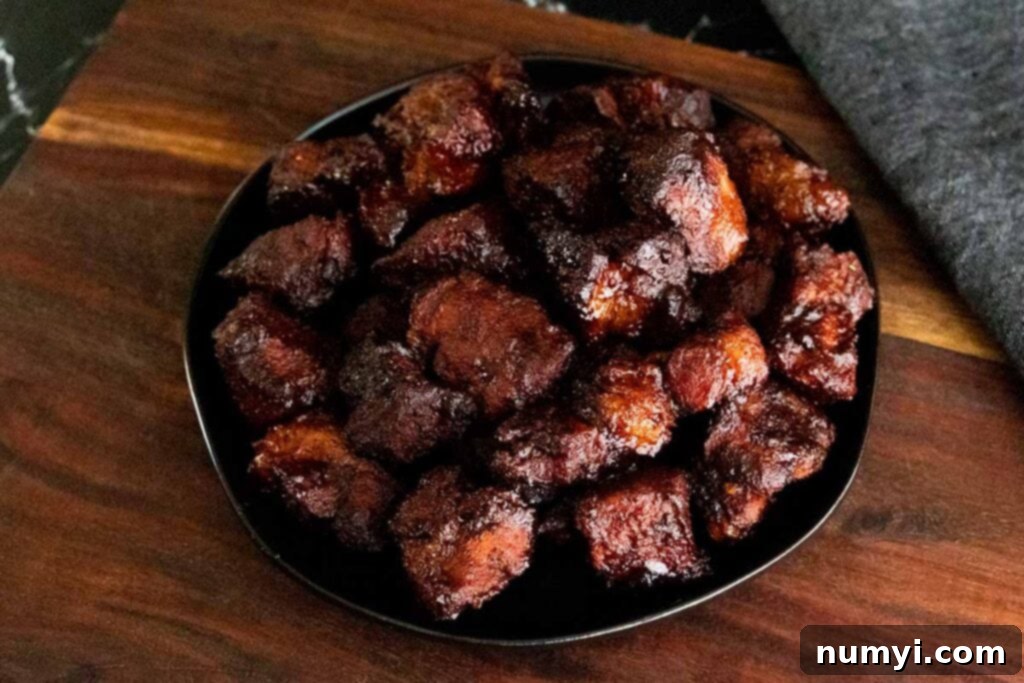
If you’re looking to expand your barbecue repertoire with other mouth-watering smoked recipes, be sure to explore some of our other amazing options listed below!
Expert Tips for Flawless Pork Butt Burnt Ends
- Trim the fat, but don’t go crazy. Aim to remove most of the thick, hard fat caps, but leave some of the softer intramuscular fat. This balance ensures your burnt ends stay incredibly juicy while allowing the rub and smoke to penetrate effectively, creating that crucial bark. Too much fat and your flavor won’t stick, too little and they could dry out.
- Binder? Totally optional, but highly recommended. A thin layer of yellow mustard acts as an excellent adhesive for your rub, ensuring it sticks beautifully to every surface of the pork. Don’t worry, you won’t taste the mustard in the final product! If you’re out or prefer to skip it, the pork will still be delicious, but the rub might not adhere quite as uniformly.
- Stick to 225-250°F for initial smoking. This lower temperature range is ideal for maximizing smoke absorption and developing a deep, rich bark without overcooking the exterior too quickly. Let the pork slowly soak up that flavorful smoke before moving on to the braising phase. Going too hot too early will compromise that signature smoky depth.
- Wood choice matters for ultimate flavor. For pork, hickory and cherry wood are a fantastic combination. Hickory brings a robust, classic smoky punch, while cherry adds a beautiful, reddish hue to your meat and a subtle sweetness. Pecan and oak are also excellent alternatives that complement pork wonderfully. Experiment to find your personal favorite!
- Braise, but don’t overdo it. The braising step is critical for tenderizing the pork butt cubes, breaking down tough connective tissues. However, there’s a fine line between tender and mushy. Start checking for tenderness after about an hour to hit that perfect bite—they should be fork-tender but still hold their shape. Over-braising can lead to them falling apart when you try to glaze them.
- Let the glaze truly tack up. The final 45-minute glazing period, especially with stirring, is essential for transforming the liquid glaze into a sticky, caramelized coating. Don’t rush this part! This is how you achieve those luscious, candy-like burnt ends that are the hallmark of a truly great recipe. For extra tackiness, an additional 15 minutes on a rack can make all the difference.
Exciting Variations to Try
- Want more heat? If you crave a spicier kick, feel free to amp up the heat! Add an extra teaspoon or two of cayenne pepper to the rub, or incorporate a generous splash of your favorite hot sauce directly into the glaze for an immediate fiery boost.
- More tang? For a brighter, more acidic profile, consider swapping out some of the brown sugar in the glaze for maple syrup or an extra squeeze of honey. A touch of apple cider vinegar in the glaze can also introduce a delightful zing.
- Asian-style burnt ends? Take your burnt ends in a completely different direction! Craft an umami-rich glaze using a base of hoisin sauce, soy sauce, rice vinegar, a dash of sesame oil, and honey or brown sugar. This creates a wonderfully savory and slightly sweet profile perfect for an exotic twist.
- Classic Kansas City vibe? If you prefer a traditional, rich Kansas City BBQ flavor, ditch the fruit juices in the braising step. Instead, use rich beef broth for the liquid. For the glaze, choose a thick, molasses-heavy BBQ sauce and consider adding a touch of liquid smoke for extra depth if desired.
- Boozy burnt ends? Elevate your flavor profile by adding a splash of your favorite spirit. A generous pour of bourbon or whiskey in the glaze introduces a sophisticated, deep, and slightly smoky undertone that takes these burnt ends up a notch.
Frequently Asked Questions About Pork Butt Burnt Ends
Absolutely! Using a bone-in pork butt is perfectly fine. The only slight adjustment you’ll need to make is carefully cutting around the bone when cubing the pork. Once the bone is removed, proceed with cubing the meat into 1½ inch pieces just as you would with a boneless cut. The bone typically adds a little extra flavor to the meat as well!
While it’s faster than a full brisket, this recipe still requires patience for that true low-and-slow barbecue flavor. Plan for approximately 3.5 to 4 hours of active cooking and resting time. This includes prep, initial smoking, braising, and the final glazing. It’s a worthwhile investment of time for the incredible results!
Yes, you can certainly adapt this recipe for the oven if you don’t have a smoker. For the initial “smoking” phase, roast the seasoned pork cubes at 250°F (120°C) for about 1 hour. To mimic some smoke flavor, you can add a little liquid smoke to the braising liquid. Then, proceed to braise the covered pan at 275°F (135°C) as instructed. Finally, finish them uncovered at the same temperature for the glazing and tack-up phase. You’ll still achieve fantastic tenderness and flavor, just with less smoky depth.
Not at all! While pineapple juice adds a lovely subtle sweetness and helps tenderize, you have plenty of great alternatives. Apple juice is a fantastic substitute, providing a similar fruity sweetness. You could also use beer (like an amber ale or lager) for a different depth of flavor, or even rich beef broth if you prefer a more savory profile. Feel free to experiment based on your taste preferences!
You can spritz the burnt ends during the initial smoking phase, but for this specific recipe, it’s not strictly necessary. Because we cube the pork butt, there’s already a significant surface area for the smoke and rub to interact with. The subsequent braising step also ensures the meat remains incredibly moist. If you do choose to spritz, do so lightly every 30-45 minutes with a 50/50 mixture of apple cider vinegar and water. Be careful not to overdo it, as excessive spritzing can wash off your beautifully formed bark. Focus on the braising for ultimate moisture and tenderness!
Other Amazing Barbecue Recipes to Explore
Texas Style Smoked Pork Loin
Smoked Pork Tenderloin
Smoked Baby Back Ribs Recipe
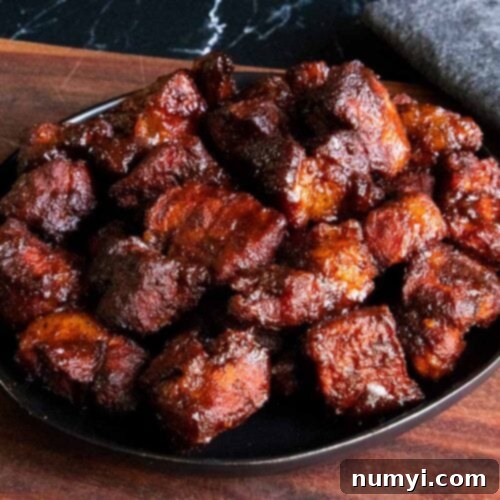
Pork Butt Burnt Ends Recipe
Print
Pin
Rate
Ingredients
The Pork
- 8 lbs Boneless Pork Butt
The Rub
- 1/2 cup Paprika
- 1/4 cup Chili powder
- 3 tbsp Brown sugar
- 3 tbsp Kosher Salt
- 3 tbsp Black pepper
- 2 tbsp Smoked paprika
- 2 tbsp Garlic powder
- 2 tbsp Onion powder
- 1 tbsp Cumin
- 1 tbsp Dried oregano
- 2 tsp Dry mustard
- 1 tsp Cayenne powder
The Glaze
- 1/2 cup Hot honey
- 1/2 cup Brown Sugar
- 1 cup Barbeque sauce Your preferred brand
- 2 tbsp Butter
- 4 tbsp Rub Leftover from above
Braising Liquid
- 24 oz Pineapple juice
- Apple juice enough to fill the disposable aluminum tin halfway coving the pork. Depends on the size. Perhaps two cups or so.
- 4 tbsp Rub Leftover from above
Instructions
Preparing The Rub
-
Mix all the spices together in a bowl until they are well combined. Set aside
Preparing The Pork
-
Trim away most of the fat using a sharp knife.
-
Cut the pork butt into 1½ inch cubes. There will be bits and pieces that don’t conform. Trim them as well and discard them.
-
Place cubed pork into a large receptacle, a bowl or disposable aluminum pan.
-
Add mustard to cubed pork and mix to coat well (optional, but recommended)
-
Add rub liberally. Mix and toss pieces and contine to add rub until well covered.
-
Place the cubes onto baking cooling racks for easy removal or set aside (to place them on the grates directly when it’s time).
Smoke
-
Get the smoker to 225 to 250 degrees F. Add your preferred wood for smoking. This recipe uses hickory and cherry woods.
-
Smoke the pork for approximately 1 hour or until the meat has good smoke color and bark is beginning to form. Internal temperature of the pork should be around 165-170 degrees F.
-
Remove the pork and increase the temperature of the smoker to 275 degrees F.
Braise
-
Place the pork in a disposable aluminum tin.
-
Add 12 ounces of pineapple juice
-
Add enough apple juice to come up the sides of the pork halfway.
-
Cover with foil and place back onto the smoker.
-
Braise for an hour to an hour and a half at 275 degrees F.
-
Check the pork for your preferred tenderness. You don’t want it to be fork tender but close to it.
-
When the pork is at your preferred tenderness, pull from the smoker.
-
Drain the braising liquid.
The Glaze
-
Add half of the hot honey, your favorite bbq sauce, brown sugar, butter, and a few tablespoons of the rub. Mix with utensils or gloved hands.
-
Repeat the process with the remaining glaze ingredients until each piece has been sufficiently covered.
-
Place back onto the smoker which should still be at 275. Cook for 45 more minutes, stirring every 15 minutes or so.
Serve
-
After 45 minutes, remove from the smoker and allow to rest for about 10-15 minutes. If you want them to really tack up, you can place them back onto the cooling racks and place back in for about 15 more minutes.
-
Serve and enjoy!
